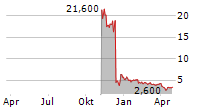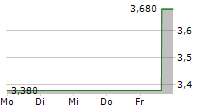
Decision follows observations of liver transaminitis without clinically significant symptoms in some subjects on azelaprag
Company will evaluate data from patients enrolled to date and share updated plans for azelaprag in Q1 2025
In parallel to evaluating azelaprag, Company will continue to advance earlier platform-derived programs, including IND submission for CNS penetrant NLRP3 inhibitor anticipated in the second half of 2025
RICHMOND, Calif., Dec. 06, 2024 (GLOBE NEWSWIRE) -- BioAge Labs (Nasdaq: BIOA) ("BioAge", "the Company"), a clinical-stage biopharmaceutical company developing therapeutic product candidates for metabolic diseases by targeting the biology of human aging, today announced that the Company has made the decision to discontinue the ongoing STRIDES Phase 2 study of its investigational drug candidate azelaprag as monotherapy and in combination with tirzepatide after liver transaminitis without clinically significant symptoms was observed in some subjects receiving azelaprag. No transaminase elevations were observed in the tirzepatide only treatment group.
"Patient safety is our top priority in the conduct of our clinical studies," said Kristen Fortney, PhD, CEO and co-founder of BioAge. "We made the difficult decision to discontinue the STRIDES Phase 2 study of azelaprag because it became clear that the emerging safety profile of the current doses tested is not consistent with our goal of a best-in-class oral obesity therapy. While this outcome is a significant disappointment, we remain encouraged by azelaprag's promising preclinical and Ph1b efficacy profile. We remain committed to our focus on developing therapies for metabolic aging. In parallel to assessing the next steps for the azelaprag program, we will continue to advance our NLRP3 inhibitor program as well as additional research programs with novel mechanisms emerging from our platform."
STRIDES is a randomized, double-blind, placebo-controlled Phase 2 clinical trial of azelaprag as monotherapy and in combination with tirzepatide that planned to enroll approximately 220 individuals with obesity aged 55 years and older (link). The trial was designed to evaluate the efficacy as measured by body weight reduction and other outcomes, safety, and tolerability of two oral doses of azelaprag (300 mg, once or twice daily) in combination with tirzepatide (5 mg subcutaneous injection once weekly). An azelaprag monotherapy arm was included to provide additional safety information.
Of 204 subjects enrolled in STRIDES as of today, 11 subjects in the azelaprag treatment groups were observed to have transaminase elevations with no clinically significant symptoms. Dosing of all subjects will be discontinued, and no additional subjects will be enrolled. Clinical follow-up of enrolled subjects will continue off drug. The Company intends to further analyze available STRIDES clinical data from all enrolled subjects. The Company has notified all study investigators and regulatory authorities including the U.S. Food and Drug Administration (FDA) of the Company's decision to discontinue enrollment. The Company intends to share updated plans for azelaprag in Q1 2025.
BioAge continues to advance its pipeline of therapeutic candidates targeting the biology of aging to treat metabolic diseases. The Company's novel class of brain-penetrant NLRP3 inhibitors, which have demonstrated high potency and a novel binding site, are progressing toward IND submission, anticipated in the second half of 2025. The NLRP3 inhibitor program targets neuroinflammation, which is linked to both metabolic and neurodegenerative diseases. In addition, BioAge is advancing multiple targets derived from its proprietary discovery platform, which analyzes molecular data spanning over 50 years of human aging trajectories.
About BioAge Labs, Inc.
BioAge is a clinical-stage biopharmaceutical company developing therapeutic product candidates for metabolic diseases, such as obesity, by targeting the biology of human aging. BioAge's lead product candidate, azelaprag, is an orally available small molecule agonist of APJ that was observed to promote metabolism and prevent muscle atrophy on bed rest in a Phase 1b clinical trial. BioAge is also developing orally available small molecule brain penetrant NLRP3 inhibitors for the treatment of diseases driven by neuroinflammation. BioAge's preclinical programs, based on novel insights from the company's discovery platform built on human longevity data, address key pathways in metabolic aging.
Forward-looking statements
This press release contains "forward-looking statements" within the meaning of, and made pursuant to the safe harbor provisions of, the Private Securities Litigation Reform Act of 1995. All statements contained in this press release that do not relate to matters of historical fact should be considered forward-looking statements, including, but not limited to, statements regarding our plans to develop and commercialize our product candidates, our business strategy, results of our ongoing or planned clinical trials, the timing of any future updates to our programs and the clinical utility of our product candidates. These forward-looking statements may be accompanied by such words as "aim," "anticipate," "believe," "could," "estimate," "expect," "forecast," "goal," "intend," "may," "might," "plan," "potential," "possible," "will," "would," and other words and terms of similar meaning. These statements involve risks and uncertainties that could cause actual results to differ materially from those reflected in such statements, including: our ability to develop, obtain regulatory approval for and commercialize our product candidates; the timing and results of preclinical studies and clinical trials; the risk that positive results in a preclinical study or clinical trial may not be replicated in subsequent trials or success in early stage clinical trials may not be predictive of results in later stage clinical trials; risks associated with clinical trials, including our ability to adequately manage clinical activities, unexpected concerns that may arise from additional data or analysis obtained during clinical trials, regulatory authorities may require additional information or further studies, or may fail to approve or may delay approval of our drug candidates; the occurrence of adverse safety events; failure to protect and enforce our intellectual property, and other proprietary rights; failure to successfully execute or realize the anticipated benefits of our strategic and growth initiatives; risks relating to technology failures or breaches; our dependence on collaborators and other third parties for the development of product candidates and other aspects of our business, which are outside of our full control; risks associated with current and potential delays, work stoppages, or supply chain disruptions; risks associated with current and potential future healthcare reforms; risks relating to attracting and retaining key personnel; failure to comply with legal and regulatory requirements; risks relating to access to capital and credit markets; and the other risks and uncertainties that are detailed under the heading "Risk Factors" included in BioAge's Form 10-Q filed with the U.S. Securities and Exchange Commission (SEC) on November 7, 2024, and other filings with the SEC filed from time to time. BioAge undertakes no obligation to publicly update any forward-looking statement, whether written or oral, that may be made from time to time, whether as a result of new information, future developments or otherwise.
Contacts
PR: Chris Patil, media@bioagelabs.com
IR: Elena Liapounova, ir@bioagelabs.com
Partnering: partnering@bioagelabs.com
Web: https://bioagelabs.com



